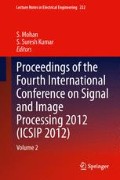Abstract
The Electroencephalogram (EEG) is a complex signal that indicates the electrical activity of brain. EEG is a signal that represents that effect of the superimposition of diverse processes in the brain. Epilepsy is a common brain disorder. Out of hundred one person is suffering from this problem. Here we study a novel scheme for detecting epileptic seizure and classifying the risk level from EEG data recorded from Epileptic patients. EEG is obtained by International 10–20 electrodes system. Singular Value Decomposition (SVD) is used for feature extraction. The efficacy of the above methods is compared based on the bench mark parameters such as Performance Index (PI), and Quality Value (QV). A group of twenty patients with known epilepsy findings are analyzed. It was identified that Elman neural network is a good post classifier in the optimization of epilepsy risk levels.
Access this chapter
Tax calculation will be finalised at checkout
Purchases are for personal use only
References
Harikumar R, GaneshBabu C, Vijayakumar T (2012) Performance analysis of elman neural networks as post classifiers for wavelet transforms based feature extraction using hard and soft thresholding methods in the classification of epilepsy risk levels from EEG signals. Eur J Sci Res 71(2):221–232
Mizrahi EM, Kellaway P (1998) Neonatal electrocephalography, in diagnosis and management of neonatal seizures. Lippincott-Raven, Philadelphia, pp 99–143
Dingle AA et al (1993) A multistage system to detect epileptic form activity EEG. IEEE Biomed Eng 40(12):1260–1268
Mizrahi EM, Plouin P, Kellaway P (1997) Neonatal seizures, in Epilepsy. In: Engel J, Pedley TA (eds) A comprehensive textbook, vol 1, Chapter 57. Lippincott–Raven, Philadelphia, pp 647–663
Yuan Y (2010) Detection of epileptic seizure based on EEG signals. In: Proceedings of the IEEE EMBS sponsored 3rd international congress on image and signal processing (CISP 2010), pp 4209–4211
Sukanesh R, Harikumar R (2006) A simple recurrent supervised learning neural network for classification of epilepsy risk levels from EEG signals. IE India J Interdisc Panels 87(2):37–43
Harikumar R, Sukanesh R, Bharthi PA (2005) Genetic algorithm optimization of fuzzy outputs for classification of epilepsy risk levels from EEG signals. IE India J Interdisc Panels 86(1):9–17
Mirzaei A, Ayatollahi A, Gifani P, Salehi L (2010) EEG analysis based on wavelet- spectral entropy for epileptic seizures detection. In: Proceedings of the 3rd international conference on biomedical engineering and informatics (BMEI 2010), Changai, pp 878–882
Haselsteiner E, Pfurtscheller G (2000) Using time-dependent neural networks for EEG classification. IEEE Trans Rehabil Eng 8(4):457–463
Xanthanopoulus P et al (2010) A novel wavelet based algorithm for spike and wave detection in absence of epilepsy. In: Proceedings of the IEEE international conference on bioinformatics and bio engineering, pp 14–19
Tzallas AT, Tsipouras MG, Fotiadis DI (2007) A time-frequency based method for the detection of epileptic seizure in EEG recording. In: Proceedings of the 12th IEEE international symposium on computer based medical systems (CBMS’07), pp 23–27
Kozek W, Hlawatsch F, Kirchauer H, Trautwein U (1994) Correlative time frequency analysis and classification of nonstationary random processes. In: Proceedings of the IEEE-SP international symposium on time-frequency and time-scale analysis, pp 417–420
Kandel ER, Schwartz JH, Jessell TM (1991) Principles of neural science, 3rd edn. Elsevier/North-Holland, New York
Nakamura A, Sugi T, Ikeda A, Kakigi R, Shibasaki H (1996) Clinical application of automatic integrative interpretation of awake background EEG: quantitative interpretation, report making, and detection of artifacts and reduced vigilance level. Electroencephalogr Clin Neurophysiol 98:103–112
Mormann F, Andrzejak RG, Elger CE, Lehnertz K (2007) Seizure prediction: the long and winding road. Brain 130:314–333
Van Drongelen W, Nayak S, Frim DM et al (2003) Seizure anticipation in pediatric epilepsy: use of Kolmogorov entropy. Pediatr Neurol 29:207–213
Lehnertz K, Mormann F, Kreuz T et al (2003) Seizure prediction by nonlinear EEG analysis. IEEE Eng Med Biol Mag 22:57–63
Firpi H, Smart O, Worrell G, Marsh E, Dlugos D, Litt B (2007) Highfrequency oscillations detected in epileptic networks using swarmed neural-network features. Ann Biomed Eng 35:1573–1584
Staba RJ, Wilson CL, Bragin A, Fried I, Engel JJ (2002) Quantitative analysis of high-frequency oscillations (80–500 Hz) recorded in human epileptic hippocampus and entorhinal cortex. J Neurophysiol 88:1743–1752
Rajna P, Clemens B, Csibri E et al (1997) Hungarian multicentre epidemiologic study of the warning and initial symptoms (prodrome, aura) of epileptic seizures. Seizure 6:361–368
Acknowledgments
The authors express their sincere thanks to the Management and the Principal of Bannari Amman Institute of Technology, Sathyamangalam for providing the necessary facilities for the completion of this paper. This research is also funded by AICTE RPS.:F No 8023/BOR/RID/RPS-41/2009-10, dated 10th Dec 2010.
Author information
Authors and Affiliations
Corresponding author
Editor information
Editors and Affiliations
Rights and permissions
Copyright information
© 2013 Springer India
About this paper
Cite this paper
Harikumar, R., Ganeshbabu, C., Balasubramani, M., Sinthiya, P. (2013). Analysis of SVD Neural Networks for Classification of Epilepsy Risk Level from EEG Signals. In: S, M., Kumar, S. (eds) Proceedings of the Fourth International Conference on Signal and Image Processing 2012 (ICSIP 2012). Lecture Notes in Electrical Engineering, vol 222. Springer, India. https://doi.org/10.1007/978-81-322-1000-9_3
Download citation
DOI: https://doi.org/10.1007/978-81-322-1000-9_3
Published:
Publisher Name: Springer, India
Print ISBN: 978-81-322-0999-7
Online ISBN: 978-81-322-1000-9
eBook Packages: EngineeringEngineering (R0)

